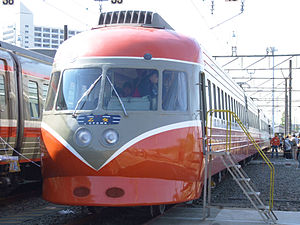You can help expand this article with text translated from the corresponding article in Japanese. (October 2018) Click [show] for important translation instructions.
|
The Odakyu 3000 series (小田急3000形, Odakyū sanzen-gata) or SE (Super Express), later becoming SSE (Short Super Express), was a "Romancecar" electric multiple unit (EMU) train type operated by the Odakyu Electric Railway in the Tokyo area of Japan. It was the recipient of the inaugural Blue Ribbon Award presented by the Japan Railfan Club in 1958.
| Odakyu 3000 series SE/SSE | |
|---|---|
 Preserved Odakyu 3000 series SE at Ebina depot (October 2007) | |
| In service | 1957–1991 |
| Manufacturer | Nippon Sharyo, Kawasaki Heavy Industries[1] |
| Family name | Romancecar |
| Constructed | 1957–1959 |
| Entered service | July 1957 |
| Scrapped | 1992 |
| Number built | 32 vehicles |
| Formation | 8 cars per set (initial) 5 cars per set (from 1968) |
| Capacity | 348 (initial)[1] 316 (from 1962)[1] 222 (from 1968)[2] |
| Operators | Odakyu Electric Railway |
| Specifications | |
| Car length | 15,950 mm (lead car, initial) 16,150 mm (lead car, from 1968) 12,700 mm (intermediate car) |
| Width | 2,864 mm (lead car, intermediate car with pantograph) 2,800 mm (intermediate car without pantograph) |
| Height | 3,450 mm (lead car, intermediate car without pantograph) 4,015 mm (intermediate car with pantograph) |
| Maximum speed | 110 km/h (operating) 147.5 km/h (design)[3] |
| Weight | 146.75 t (initial)[4] 159 t (from 1962)[5] 113.47 t (from 1968)[2] |
| Traction system | Resistor control (electric camshaft) |
| Power output | 100 kW (375 V terminal voltage, 1,800 rpm) |
| Transmission | Axis Cardan Driveshaft |
| Acceleration | 1.6 km/h/s[6] |
| Deceleration | 4.15 km/h/s[6] |
| Electric system(s) | 1,500 V DC |
| Current collector(s) | Overhead lines |
| Braking system(s) | Dynamic and electromagnetic braking (HSC-D)[6] |
| Safety system(s) | OM-ATS, ATS-S |
| Track gauge | 1,067 mm (3 ft 6 in) |
| Notes/references | |
This train won the 1st Blue Ribbon Award in 1957. | |

Design
editThe 3000 series trains were articulated with shared bogies, six of which were motored.[7]
Formations
edit8-car 3000 series SE
editThe original 8-car "SE" sets were formed as shown below.[7]
| Designation | M1c | M2 | M3 | M4 | M5 | M6 | M7 | M8c |
|---|---|---|---|---|---|---|---|---|
| Weight (t) | 24.87 | 17.19 | 16.00 | 16.28 | 15.13 | 15.75 | 17.44 | 24.34 |
| Seating capacity | 52 | 40 | 38 | 44 | 44 | 38 | 40 | 52 |
The M2 and M7 cars were each fitted with one PT42-K lozenge-type pantograph.[7]
Interior
edit-
Inside
-
Refreshment Counter
-
Driver's Cab
-
Blue Ribbon Award plaque
History
editService first started in 1957 with the SE trainset, which, on a trial run, attained the world speed record at the time (145 km/h (90 mph)) for a narrow gauge train. This record gave impetus for the design of the first Shinkansen, the 0 Series.
This train adopted articulated bogies for comfort, efficiency, economy, and speed. This feature would be adopted by the NSE, LSE, HiSE, and VSE trainsets.
The 50th anniversary of the Romancecar's narrow gauge world speed record was celebrated on 28 September 2007.[8]
The trains were reformed from eight cars to five in 1968, becoming the 3000 series SSE (Short Super Express).
The SE trains were in service from 1957 to 1968, and the SSE from 1968 to 1991.
References
edit- ^ a b c 大幡哲海 (1988). "小田急ロマンスカー3000,3100,7000系 車両のあゆみ". 鉄道ピクトリアル (in Japanese) (491). Railway Pictorial: 17.
- ^ a b 大幡哲海 (1988). "小田急ロマンスカー3000,3100,7000系 車両のあゆみ". 鉄道ピクトリアル (in Japanese) (491). Railway Pictorial: 19.
- ^ 山村秀幸 (1991). "小田急の車両技術の回顧 SE車". 鉄道ピクトリアル (in Japanese) (546). Railway Pictorial: 85.
- ^ 生方良雄 (2005). 小田急ロマンスカー総覧 (in Japanese). Railway Pictorial. p. 167.
- ^ 生方良雄 (2002). "私鉄車両めぐり 小田急電鉄(補遺)". 鉄道ピクトリアル アーカイブスセレクション (in Japanese) (1). Railway Pictorial: 80.
- ^ a b c T (2002). 鉄道ピクトリアル アーカイブスセレクション 通巻1号: お手並み拝見 見たり・聞いたり・乗ったりの記 小田急SE車 (in Japanese). Railway Pictorial. p. 113.
- ^ a b c Ohata, Tetsuhiro (May 1992). "小田急3000形SE車のあゆみ その2" [History of the Odakyu 3000 series SE (Part 2)]. Japan Railfan Magazine. Vol. 32, no. 373. Japan: Koyusha Co., Ltd. pp. 60–67.
- ^ 50年前の特急ロマンスカーが登場 (in Japanese). Asahi. 3 October 2007. Archived from the original on 15 December 2007. Retrieved 24 October 2008.